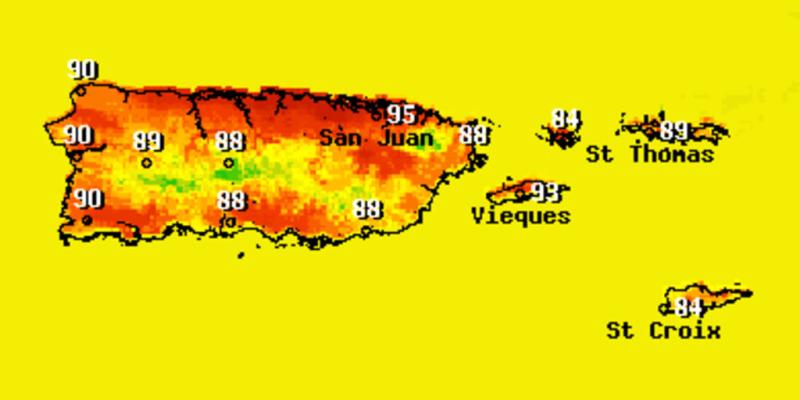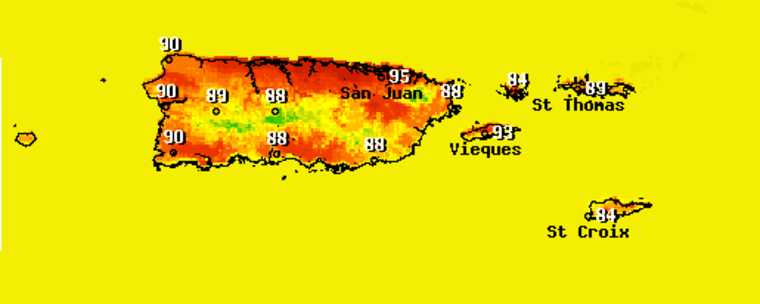Puerto Rico faces 'dangerous situation' with record-breaking heat



Puerto Rico endured temperatures that felt as hot as 125 degrees Fahrenheit this week, according to the National Weather Service, as the U.S. territory experiences excessive heat conditions that will continue for another week.
The tropical island already experienced record-breaking minimum and maximum temperatures for this time of year on Monday and Tuesday, when it jumped to 95 degrees. But the heat index, which measures how temperatures feel like to the human body, surpassed 120 degrees Fahrenheit on Tuesday in parts of Puerto Rico, even peaking to 125 in the northern towns.
 High temperatures in Puerto Rico and surrounding islands Wednesday felt even hotter and raised the heat index to 125 degrees. NOAA
High temperatures in Puerto Rico and surrounding islands Wednesday felt even hotter and raised the heat index to 125 degrees. NOAA
The combination of a low-pressure system near Florida and a high-pressure system just east of Puerto Rico has essentially formed a "heat dome" that has remained stuck in the same place for various days, John Morales, a certified consulting meteorologist at ClimaData and a hurricane specialist for NBC Miami, told NBC News.
A combination of dry air, unusually warm ocean waters and high humidity is causing people to feel the heat more severely.
The National Weather Service usually issues a heat advisory when the heat index reaches or exceeds 105 degrees Fahrenheit, "so when it's 125, that's incredibly dangerous," Morales said.
The combination of high humidity and high temperatures can be dangerous because, when the humidity in the air is high, less sweat can evaporate off the human body to cool it off.
The severe weather conditions are making Puerto Rican residents more vulnerable to heat exhaustion and, in extreme cases, heat strokes.
"We are 'sailing in uncharted waters' and we cannot let our guard down in the face of excessive heat," Ada Monzon, chief meteorologist at Wapa Television in Puerto Rico, tweeted in Spanish alongside instructions of what to do during a heat stroke. "Take care of your health, that of your loved ones and your pets."
A heat advisory is still in effect for much of the northern and western part of the island as the National Weather Service estimates the heat index to reach 111 degrees Fahrenheit Wednesday.
Power outages aggravate the danger
As residents look for alternatives to cool down amid the extreme heat, electricity demand in Puerto Rico has increased, testing the limits of a patched-up power grid that has not been permanently rebuilt after hurricanes Maria and Fiona.
More than 40,000 power customers lost power on Monday during extreme heat conditions after a power plant went out of service while registering a demand of 3,072 megawatts, the highest so far this year, Puerto Rican national newspaper El Nuevo Dia reported.
The same power plant failed the following day due to issues with the boiler, a repair that "will take time" to fix, according to the Puerto Rico Power Authority, which is in charge of power generation.
"Being without power during extreme heat events is a serious risk, and can even lead to death," Monzon tweeted alongside a scientific article on how blackouts during heat waves amplify mortality and morbidity risks.
Luma Energy, which is in charge of power distribution on the island, said it has been "closely monitoring the likelihood of more temporary outages" due to power generation issues.
"To minimize the likelihood of these interruptions, reduce your energy consumption if possible," Luma Energy said on Twitter Tuesday.
The climate change connection
Morales said the unprecedented heat in Puerto Rico has a connection to climate change.
"There's emerging science indicating that there's a connection to climate change here — the heat wave in Puerto Rico right now has been made at least five times more likely to happen due to man-made global warming," Morales said after reviewing data from the Climate Shift Index.
"It's not just climate, and it's not just weather. It's a combination of the two that's leading to what, frankly, is a dangerous situation," he said.
Morales said the difference in temperatures between the Arctic and the mid-latitudes tends to drive the strength of a jet stream, which generally controls how weather systems move.
"But the Arctic is warming so fast compared to the rest of the Northern Hemisphere," Morales said. "So, less of a temperature difference means that the jet stream is weaker," causing weather systems to move slowly or remain in one place for a longer time period.
Morales added that Puerto Rico is likely "not going to see the heat wave break" unless something in the jet stream changes.
The National Weather service said extreme heat conditions may persist throughout the weekend and until Tuesday.



Not to take anything away from Puerto Rico, but it should prove to be hotter on NT today.
best put on your hazmat gear ...
Here ya go....
"But the Arctic is warming so fast compared to the rest of the Northern Hemisphere," Morales said. "So, less of a temperature difference means that the jet stream is weaker," causing weather systems to move slowly or remain in one place for a longer time period."
Another simplistic and alarmist statement that lacks verification. This is a temporary local weather condition that will resolve with time. What really happens, is that with almost 24 hours of sunlight the Arctic warms every summer, there is less temperature contrast from north to south, and the jet stream retreats northward. Airmasses over the continental US (CONUS) can become almost stationary and weather conditions at the surface can be persistent, sometimes for several days or even weeks.
Jeez folks - send them PR folks to the SW starting next month and they can enjoy our cool, daily weather from July to October with the temps in the 100's + - consistently, not just when the Arctic blows a little bit.
Wow 125 and to think I was bitching cause it was 26 in the office yesterday